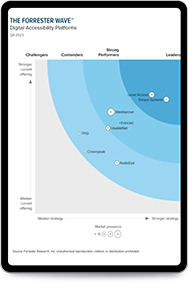Accessibility testing tools
Feb 13, 2024
There are a variety of tools available to test whether a digital experience is usable by people with disabilities. Accessibility testing tools are cost-effective, easy to use, and can catch issues across a digital experience immediately.
What are accessibility testing tools?
Accessibility testing tools, often referred to as automated testing tools, are software applications or downloads designed to evaluate digital content—such as websites, mobile apps, and PDF documents—for their conformance with accessibility standards and guidelines. They can help organizations determine, quickly and in broad strokes, whether their website is accessible to people with disabilities.
What are the types of accessibility testing tools?
There are two main types of accessibility testing: automated and manual. Most accessibility testing tools are used in automated accessibility testing. Manual testing involves human judgment and is often performed by accessibility professionals. Automated testing is usually less in-depth, but provides a reliable, consistent means of identifying accessibility bugs rapidly at scale. Here are some of the most common accessibility testing tools organizations use in their accessibility practices.
Web accessibility tools
Scanners
For a quick, at-a-glance survey of a website’s accessibility, teams can start with a free page scanner, like the one we offer at Level Access.For a quick scan of a single web page that provides slightly more detail, the WAVE tool by WebAIM scans a URL, delivering a report that uses a simple red, yellow, or green icon to show errors, warnings, and elements that pass.
Browser extensions
Developers use browser extensions to test and resolve issues on the spot in a live (or sometimes, pre-production) website or web app. Other team members may also use these tools to run quick, multi-page scans to test for accessibility issues across a specific series of pages, especially upon publication.By leveraging browser extensions earlier in the development process (when the tool allows it), teams prevent accessibility bugs from making their way downstream and into live experiences. This is especially true when the extension is connected to an accessibility management platform, as is the case with the Level Access browser extension.
Test automation Plugins / Packages (e.g., CI/CD integrations)
By utilizing test automation plugins or accessibility testing libraries, organizations can build accessibility testing into their existing test automation frameworks. Once the appropriate package is downloaded and installed, users can run tests locally and surface accessibility issues during the development pipeline. This promotes a more proactive and preventative approach to building digital experiences with accessibility in mind.To learn more about embedding accessibility in test automation and the benefits of this proactive approach, access our guide to agile accessibility in development.
Design accessibility tools
A color contrast checker, like the Level Access Accessible Color Picker for Chrome, is an online tool that enables users to select or enter the hex codes of foreground and background color to reveal the contrast ratio between the two, ensuring you meet WCAG requirements. If the two colors do not have a high enough contrast, these tools will offer suggestions or allow you to adjust either color until the proper contrast is met, providing the new hex code. The WebAIM Contrast Checker is another popular tool in this category.Additionally, designers may want to explore freely available accessibility design kits by leading brands and thought leaders in Figma.
Mobile accessibility tools
Two tools serve the mobile accessibility space. Accessibility Scanner checks the accessibility of Android apps. For iOS, Accessibility Inspector can be used. Both apps are utilized by development and QA teams.
Document accessibility tools
The Document Accessibility Toolbar is a dedicated accessibility ribbon menu for Microsoft Word that makes it quicker and easier to create accessible documents. This toolbar features a range of hand-picked and custom-built functions to optimize and validate a document for accessibility. For Windows users, the PDF Accessibility Checker (PAC) tool checks PDFs for accessibility. Mac users may want to explore the Accessibility Checker capabilities in Adobe Acrobat Professional.
Why is utilizing accessibility testing tools important?
Accessibility testing tools deliver a reliable, consistent means of rapidly identifying accessibility barriers, significantly decreasing the frequency of bugs, and improving accessibility across various digital assets. Additionally, accessibility testing tools contribute to the overall quality of software. By catching accessibility issues early in the development process, developers can prevent the accumulation of technical debt and reduce the need for costly fixes. Incorporating accessibility testing in the software development life cycle improves the overall experience for people with disabilities, contributing to equal access and inclusivity in the digital world.
